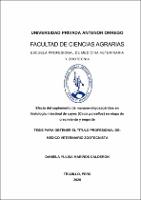Mostrar el registro sencillo del ítem
Efecto del suplemento de manano-oligosacáridos en histología intestinal de cuyes (Cavia porcellus) en etapa de crecimiento y engorde
| dc.contributor.advisor | Lombardi Pérez, César | |
| dc.contributor.author | Mariños Calderón, Daniela Yulisa | |
| dc.creator | Mariños Calderón, Daniela Yulisa | |
| dc.date.accessioned | 2020-11-16T11:52:42Z | |
| dc.date.available | 2020-11-16T11:52:42Z | |
| dc.date.issued | 2020 | |
| dc.identifier.uri | https://hdl.handle.net/20.500.12759/6792 | |
| dc.description.abstract | La presente investigación evalúa el efecto de los manano– oligosacáridos (MOS) sobre la histología intestinal de cuyes (Cavia porcellus) alimentados durante la fase de crecimiento (15-30 días) y engorde (31-60 días). Se utilizaron 80 cuyes machos de la línea Perú, Ecotipo Cajamarquino de alrededor 15 días de edad, con un peso inicial promedio de 392.50g, los cuales fueron distribuidos a través de un diseño de bloques completamente al azar, siendo el factor de bloqueo el sexo, con cuatro tratamientos y cuatro repeticiones por cada tratamiento, para crecimiento: fue dieta base sin MOS (T0), dieta base con 0.2% de MOS (T20), dieta base con 0.4% de MOS (T40) y dieta base con 0.6% de MOS (T60). En engorde: fue dieta base sin MOS (T0), dieta base con 0.1% de MOS (T10), dieta base con 0.2% de MOS (T20) y dieta base con 0.3% de MOS (T30); se utilizaron cinco cuyes por unidad experimental. El periodo de aplicación de los tratamientos y evaluaciones fue de 45 días, para evaluar la histología intestinal; las muestras fueron colectadas, en la etapa de crecimiento a los 30 días de vida y en la etapa de engorde a los 60 días de vida. Las mismas que fueron enviadas al laboratorio para realizar los cortes histológicos correspondientes. Los datos obtenidos en la etapa de crecimiento mostraron un ligero incremento en las variables de estudio, con respecto al grupo control, en la adición de MOS usada al 2%, 4% y 6% (P>0.05), en la etapa de crecimiento, no se evidencia diferencia estadística. En la etapa de engorde en la adición de MOS al,1%,2% y 3%, no se muestra diferencia estadística (p>0.05), para longitud de vellosidad, pero si hay una diferencia numérica favorable en el T1, T2 y T3, en comparación al grupo control para este mismo parámetro, en relación a la profundidad de cripta si existe diferencia estadística, agregando así mismo que en el análisis de contrasté encontramos un resultado significativo con las variables estudiadas. | es_PE |
| dc.description.abstract | The present investigation evaluates the effect of mannanoligosaccharides (MOS) on the intestinal histology of guinea pigs (Cavia porcellus) fed during the growth phase (15-30 days) and fattening (31-60 days). Eighty male guinea pigs of the Peru line, Eco-type Cajamarquino, around 15 days old, with an average initial weight of 392.50g, were used, which were distributed through a completely randomized block design, the blocking factor being sex, with four treatments and four repetitions for each treatment, for growth: it was a base diet without SOM (T0), a base diet with 0.2% SOM (T20), a base diet with 0.4% SOM (T40) and a base diet with 0.6% of MOS (T60). In fattening: it was a base diet without MOS (T0), a base diet with 0.1% of MOS (T10), a base diet with 0.2% of MOS (T20) and a base diet with 0.3% of MOS (T30); Five guinea pigs were used per experimental unit. The period of application of the treatments and evaluations was 45 days, to evaluate the intestinal histology; the samples were collected, in the growth stage at 30 days of life and in the fattening stage at 60 days of life. The same ones that were sent to the laboratory to make the corresponding histological sections. The data obtained in the growth stage showed a slight increase in the study variables, with respect to the control group, in the addition of MOS used at 2%, 4% and 6% (P> 0.05), in the growth stage, no statistical difference is evidenced. In the fattening stage in the addition of MOS at 1%, 2% and 3%, no statistical difference is shown (p> 0.05), for hair length, but if there is a favorable numerical difference in T1, T2 and T3, compared to the control group for this same parameter, in relation to crypt depth if there is a statistical difference, adding that in the contrast analysis we found a significant result with the variables studied | en_US |
| dc.description.uri | Tesis | es_PE |
| dc.format | application/pdf | es_PE |
| dc.language.iso | spa | es_PE |
| dc.publisher | Universidad Privada Antenor Orrego | es_PE |
| dc.relation.ispartofseries | T_MED.VETE_149 | |
| dc.rights | info:eu-repo/semantics/openAccess | es_PE |
| dc.rights.uri | https://creativecommons.org/licenses/by/4.0/ | es_PE |
| dc.source | Universidad Privada Antenor Orrego | es_PE |
| dc.source | Repositorio Institucional - UPAO | es_PE |
| dc.subject | Manano | es_PE |
| dc.subject | Engorde | es_PE |
| dc.title | Efecto del suplemento de manano-oligosacáridos en histología intestinal de cuyes (Cavia porcellus) en etapa de crecimiento y engorde | es_PE |
| dc.type | info:eu-repo/semantics/bachelorThesis | es_PE |
| thesis.degree.level | Título Profesional | es_PE |
| thesis.degree.grantor | Universidad Privada Antenor Orrego. Facultad de Ciencias Agrarias | es_PE |
| thesis.degree.name | Médico Veterinario Zootecnista | es_PE |
| thesis.degree.discipline | Medicina Veterinaria y Zootecnia | es_PE |
| dc.subject.ocde | https://purl.org/pe-repo/ocde/ford#4.03.00 | es_PE |
| renati.type | https://purl.org/pe-repo/renati/type#tesis | es_PE |
| renati.level | https://purl.org/pe-repo/renati/level#tituloProfesional | es_PE |
| renati.discipline | 841056 | es_PE |
| dc.publisher.country | PE | es_PE |
Ficheros en el ítem
Este ítem aparece en la(s) siguiente(s) colección(es)
-
Veterinaria y Zootecnia [197]


